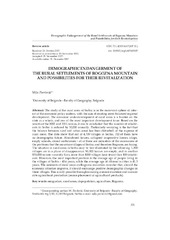Приказ основних података о документу
Demographic endangerment of the rural settlements of Rogozna mountain and possibilities for their revitalization
| dc.creator | Pavlović, Mila | |
| dc.date.accessioned | 2021-09-24T15:39:03Z | |
| dc.date.available | 2021-09-24T15:39:03Z | |
| dc.date.issued | 2017 | |
| dc.identifier.issn | 1450-7552 | |
| dc.identifier.uri | https://gery.gef.bg.ac.rs/handle/123456789/869 | |
| dc.description.abstract | The study of the rural areas of Serbia is in the narrowest sphere of interest of the economic policy makers, with the aim of creating more balanced regional development. The economic underdevelopment of rural areas is a burden on the state as a whole, and one of the most important development issue. Based on the results of the 2002 and 2011 census, it can be concluded that the number of inhabitants in Serbia is reduced by 30,000 annually. Particularly worrying is the fact that the balance between rural and urban areas has been disturbed, at the expense of rural areas. The data show that out of 4,709 villages in Serbia, 700 of them have no demographic future. Abandoned houses, collapsed cooperative homes, shops, empty schools, closed ambulances - all of these are indicators of the seriousness of the problems that the mountain villages of Serbia, and therefore Rogozne, are facing. The situation in rural areas in Serbia may be best illustrated by the following: 1,200 villages are in a phase of disappearance, 50,000 houses are empty, and in another 150,000 no one currently lives, more than 1000 villages have fewer than 100 inhabitants. However, the most important problem is the average age of people living in the villages of Serbia - 43.6 years, while the average age of citizens in cities is 41.3 years. The residents of rural areas on Rogozna mountain consider that, should the economic situation improve, it should encourage positive demographic changes in these villages. This is only possible through ensuring a secure existence and sustainable agricultaral production (secure placement of agricultural products). | en |
| dc.publisher | Beograd : Univerzitet u Beogradu - Geografski fakultet | |
| dc.relation | info:eu-repo/grantAgreement/MESTD/Basic Research (BR or ON)/176008/RS// | |
| dc.rights | openAccess | |
| dc.rights.uri | https://creativecommons.org/licenses/by/4.0/ | |
| dc.source | Zbornik radova - Geografski fakultet Univerziteta u Beogradu | |
| dc.subject | emigration | en |
| dc.subject | rural areas | en |
| dc.subject | depopulation | en |
| dc.subject | agriculture | en |
| dc.subject | Rogozna | en |
| dc.title | Demographic endangerment of the rural settlements of Rogozna mountain and possibilities for their revitalization | en |
| dc.type | article | |
| dc.rights.license | BY | |
| dcterms.abstract | Павловић, Мила; | |
| dc.citation.issue | 65-1a | |
| dc.citation.spage | 331 | |
| dc.citation.epage | 342 | |
| dc.citation.other | (65-1a): 331-342 | |
| dc.citation.rank | M51 | |
| dc.identifier.doi | 10.5937/zrgfub1765331P | |
| dc.identifier.fulltext | https://gery.gef.bg.ac.rs/bitstream/id/772/867.pdf | |
| dc.identifier.rcub | https://hdl.handle.net/21.15107/rcub_gery_869 | |
| dc.type.version | publishedVersion |


